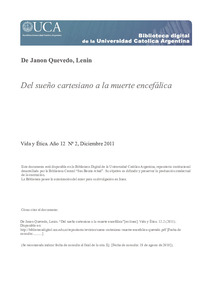Por favor, use este identificador para citar o enlazar este ítem:
https://repositorio.uca.edu.ar/handle/123456789/1606| Título: | Del sueño cartesiano a la muerte encefálica | Autor: | De Janon Quevedo, Lenin | Palabras clave: | Descartes René, 1596-1650; MUERTE; RACIONALISMO; FILOSOFIA; SUEÑO | Fecha de publicación: | 2011 | Editorial: | EDUCA | Cita: | De Janon Quevedo, Lenin. “Del sueño cartesiano a la muerte encefálica”[en línea]. Vida y Ética. 12.2 (2011). Disponible en: https://repositorio.uca.edu.ar/handle/123456789/1606 | Resumen: | Resumen: Entre el sueño y la muerte hay “sólo una distancia”. El dormir encierra un misterio que se aviva con los sueños y, al parecer, habrían prefigurado al mismo método científico moderno. Descartes pensó que en sus sueños se transmitía el espíritu de la verdad. El alma soñadora e inmortal adquirió notoriedad en su dualismo, al tiempo que dejó de asociársela con la muerte. Tres siglos después, la medicina permitió identificar individuos que estaban muertos, aunque pareciesen dormidos (coma dépassé). Así reapareció la asociación sueño-muerte, pero ahora con médicos provistos del “diagnóstico anátomo-clínico” que, por su herencia cartesiana, demandará evidencias. La duda metódica integrada al pensamiento científico, aportaría incertidumbre a las formulaciones cerebrales de la muerte. Este trabajo repasa el valor de los sueños para el pensamiento occidental, busca al “hombre-máquina” dentro de los criterios neurológicos del fallecido y, con la ayuda de la Filosofía, intenta comprender algunas objeciones en torno a la licitud del diagnóstico de “muerte encefálica”. Se propone una revisión sucinta de la obra del filósofo francés y su reflejo en aspectos del debate ofrecido por la literatura médica. Abstract: Between sleep and death, there is “just a distance”. Sleeping involves a mystery that becomes alive with dreams, which apparently prefigured the same modern scientific method. Descartes thought that his dreams transmitted the spirit of the truth. In his dualism, the dreamy and immortal soul acquired notoriety, while it stopped being associated with death. Three centuries later, medicine made possible to identify if individuals were already dead, although they seemed to be sleeping (coma dépassé). In that way sleep-death association reemerged, but now with physicians provided with “anatomical-clinical diagnosis”, which would demand evidences due to its Cartesian legacy. The methodical doubt integrated to scientific thinking would bring about uncertainty to the brain-based formulations of death. This work reviews the value of dreams for western thinking, looks for the “manmachine” within the deceased person´s neurological criteria and tries to understand some objections about the legality of the diagnosis of “brain death”, based on philosophy. A brief review of the French philosopher´s work is proposed as well as his stamp appearing in different aspects of the debate offered by the medical Literature. |
URI: | https://repositorio.uca.edu.ar/handle/123456789/1606 | Disciplina: | BIOETICA | Derechos: | Acceso Abierto | Fuente: | Versión original impresa en Sistema de Bibliotecas UCA: Vida y Ética Año 12, Nº 2, 2011 |
| Aparece en las colecciones: | VE - 2011 Año 12 nro. 2 |
Ficheros en este ítem:
| Fichero | Descripción | Tamaño | Formato | |
|---|---|---|---|---|
| sueno-cartesiano-muerte-encefalica-quevedo.pdf | 320,3 kB | Adobe PDF |  Visualizar/Abrir |
Visualizaciones de página(s)
496
comprobado en 30-abr-2024
Descarga(s)
452
comprobado en 30-abr-2024
Google ScholarTM
Ver en Google Scholar
Este ítem está sujeto a una Licencia Creative Commons

